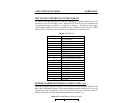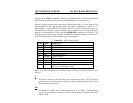
MFJ-1278B MULTI-MODE TROUBLESHOOTING
Verify that there is activity on the control bus READ and WRITE lines, the 3 CHIP-
ENABLE lines on the memories (U23-25, pins 20), the IOREQ line on U21 pin 36, and the
INT line on pin 16. Each of these lines should show activity, and if any line is quiet this is a
sign of trouble.
Logic lines that show no activity may often be traced to a short on the pc board, probably due
to a solder splash or bridge. Logic lines that look the same can be traced back to a short
between two or more of the logic lines. Shorted data or address lines are found with a DVM,
in a point-to-point continuity check.
Address and data line shorts may also show up as lack of activity on the control bus lines,
especially the chip selects. Check each of the 16 address and 8 data lines for activity. Any
lines showing a lack of activity are not operating properly.
If you suspect problems with address or data lines, try removing all the memory chips. Each
address and data line will now show a distinct pattern. The address lines should be (possibly
distorted) square waves whose periods increase by a factor of two on successive lines as you
step line by line from A0 to A15.
If you decide to use an ohmmeter to check for shorted lines, use a low voltage/low current
test instrument. (Most Modern DVMs are fine for this.) If in doubt, remove any ICs
connected to the lines you are measuring. If you suspect a short, check the high density areas
of the PC board for the problem. In most cases the short will be found there. It is very
unlikely that the PC board itself will have a short.
Symptom: Modem won't calibrate or key transmitter.
Troubleshooting improper calibration amounts to checking for proper signals at U21 and
following up any improper signal. If the calibration signal is present, but you cannot
successfully calibrate the frequency, you may have an out-of- spec frequency determining
component. Check the values of the appropriate passive components. Also, check the
placement of jumpers! As a last resort, check the signal frequency with a frequency counter.
Note that, due to frequency jitter while calibrating the demodulator, the STA and CON LEDs
may blink somewhat even when the 1700 Hz demodulator frequency is correct.
Calibration of the demodulator and the modulator tones are discuss in the Appendix chapter.
If the transmitter doesn't key, the problem may be in the watchdog timer, U7, or the PTT
transistors, Q10 or Q20. Check especially for an open timing capacitor C31 or a bad solder
connection associated with R83.


















